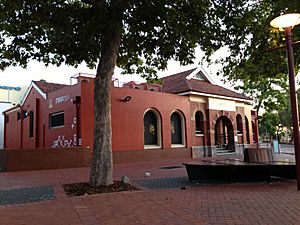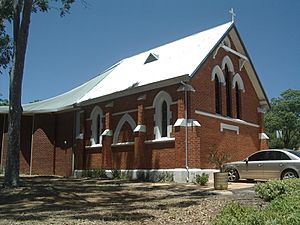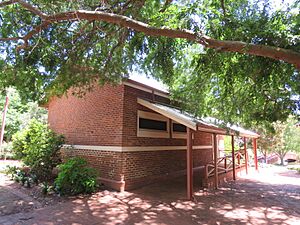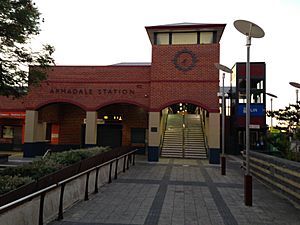Armadale, Western Australia facts for kids
Quick facts for kids ArmadalePerth, Western Australia |
|||||||||||||||
|---|---|---|---|---|---|---|---|---|---|---|---|---|---|---|---|

The state heritage listed Armadale District Hall
|
|||||||||||||||
| Postcode(s) | 6112 | ||||||||||||||
| Area | 8.4 km2 (3.2 sq mi) | ||||||||||||||
| Location | 28 km (17 mi) from Perth CBD | ||||||||||||||
| LGA(s) | City of Armadale | ||||||||||||||
| State electorate(s) |
|
||||||||||||||
| Federal Division(s) | Burt | ||||||||||||||
|
|||||||||||||||
Armadale is a suburb found in Perth, Western Australia. It is part of the City of Armadale, located on the south-eastern side of the Perth city area.
Armadale is an important meeting point for two major highways: the South Western Highway and the Albany Highway. These roads connect Perth to the South West and Great Southern regions of Western Australia. Armadale is also the final stop for the Armadale railway line, which is one of Perth's main train lines.
Contents
Armadale's Past: A Journey Through Time
How Armadale Began
Long before European settlers arrived, the area now known as Armadale was home to Aboriginal people. They used the land's rich natural resources. Early settlers and the Aboriginal people faced challenges. This led to a small military base being set up in Kelmscott.
Kelmscott became an official town in 1830. For the next 60 years, it was the main center for settlers in the area. At first, it was hard to settle in Kelmscott because there were no roads from Perth. Also, there weren't enough workers.
Early Settlements and Mining
Over time, large pieces of land were given out. These were later divided and sold to smaller farmers. By the 1840s, many farms were started in the foothills along the Canning River and other brooks. Some early farming families included White, Stuart, Martin, Armstrong, and Mead.
In 1846, Western Australia's first mine was opened in the Armadale area. A company was formed to dig for lead or copper. However, not much metal was found, and the mining stopped in 1850. You can still find one of the old mine shafts south of Bedfordale Hill Road.
Roads and the First Inn
By 1835, a road from Perth to Kelmscott was planned. Later, roads to Albany and Bunbury were also marked out. This helped start mail services. But it wasn't until 1851 that work began to properly build the road to Kelmscott. Convicts helped with this work from 1852.
The town of Armadale started around 1853. This happened at the spot where the roads to Albany and Pinjarra met. A clever settler saw a chance to open an inn there. In 1856, Thomas Saw and his father-in-law, Henry Gibbs, got a license to sell drinks. Their inn was called the Neerigin Inn. For many years, the area was known as Neerigin or Narrogin. A hotel with this name still stands where the original inn was.
The Arrival of the Railway
In 1889, the railway line from Perth reached what is now Armadale. A train station was built there in 1897. It is believed the station was named 'Armadale' to avoid confusion with the town of Narrogin. The town that grew around the station then took this name. The name 'Armadale' was not used before the railway arrived.
The railway helped the area grow. In 1893, local people met to talk about improving local roads. In 1894, a 'Roads Board' was formed. It was first called the 'Kelmscott Roads Board'. Over the years, it changed names several times, eventually becoming the City of Armadale in 1985.
Fun Places to Visit in Armadale
Armadale has many interesting natural and cultural spots. Here are some popular ones:
- Aboriginal Interpretation Centre, Champion Lakes, Kelmscott. This center celebrates and helps people understand Nyoongar culture and history.
- Old Jarrah Tree, Armadale Shopping City. This huge tree is thought to be between 400 and 800 years old! It's one of the oldest features in Armadale's city center.
- Cole's Shaft, Summit View, Mt Richon. These are the remains of Western Australia's very first mining project.
- Minnawarra Park, Orchard Avenue, Armadale. This park is home to the History House Museum. It also has an old church and school building. The school building was moved here in 1987. It was the first time a brick building of its size was moved in one piece in Australia!
- Armadale Settlers Common, Settlers Road, Armadale. This place has many walking trails. You can find rare plants and animals here.
- Araluen Botanic Park, Roleystone.
- Churchman Brook Dam, Canning Dam and Wungong dam. These three dams provide water for Perth. They are also beautiful places to visit and see amazing engineering.
- Bungendore Park and Wungong Gorge. This area has regrown bushland. It's great for seeing nature, plants, and interesting rocks.
- Schoenstatt Shrine, Talus Drive, Mt Richon. This is a copy of a famous pilgrimage site in Germany.
- Birtwistle Local Studies Library, inside the Armadale Library. This library has many local history resources.
- Heritage Walk. You can take a walk from Armadale Railway Station up Jull Street to the Narrogin Inn and beyond to see many historic buildings.
- Former Armadale Post Office (around 1900). This building was designed by a famous architect, George Temple-Poole. The older Post and Telegraph Office from 1898 is attached to it. Today, it's the regional office for the Department of Fire and Emergency Services.
- Railway Hotel (1902). This hotel has changed its look over the years. It used to have two-story verandahs.
- Soldiers Memorial Park, Jull Street / Orchard Avenue, Armadale. This is the oldest park in Armadale. The brick monument is believed to be the oldest WWI memorial in Australia. It's a special place for Anzac Day events.
- Former Shire Council Offices, Jull Street, Armadale. The original office building is from 1902. Newer offices were built in 1967.
- St Matthews Anglican Church (1904). Designed by famous architect Sir Joseph John Talbot Hobbs, this is the oldest church in Armadale still used for its original purpose.
- Armadale Town Hall (1936). This building replaced an earlier hall from 1898.
- Bert Tyler Vintage Machinery Museum, Jull Street, Armadale. This museum has old machines. The local visitor information center is also here.
- Dr Colyer's house (1952), Jull Street, Armadale. A small house designed by architect Marshall Clifton.
- Narrogin Inn (1936), junction of Albany and South Western Highways. This two-story hotel stands near where the very first inn was in the 1850s.
- Muckross Tearooms, South Western Highway. This building reminds us of a time when people from Perth would take weekend trips to Armadale. It was also a local gym.
- Pioneer Village, Albany Highway, Armadale. This tourist spot was built in the 1980s to look like an old gold rush town. It also has a lovely playground for children.
- Elizabethan Village, Canns Road, Bedfordale. This village has buildings that look like old English Tudor houses. They were built in the late 1970s to create an English-themed tourist experience. Some buildings are copies of places linked to William Shakespeare.
Learning in Armadale: Schools and Colleges
Armadale is a center for education in the area. It has many schools and colleges:
- Two state high schools
- Four state primary schools
- Three independent schools (one goes up to Year 12)
- An Australian Trades College campus
- A campus of South Metropolitan TAFE (a college for vocational training)
History of Schools
Armadale State School started in 1899 in the Mechanics Institute Hall. A special school building was built in 1900. It started with one classroom, and more were added as the population grew. A Catholic school, St Francis Xavier, opened in 1938.
After World War II, Armadale grew quickly. Armadale Senior High School opened in 1955. It started as a high school and later included Years 11 and 12 from 1963.
In 1957, a group of Dutch families opened a school called John Calvin School (now John Calvin Christian College). It started for younger students and later added high school years. The primary school parts have since moved to other campuses.
As Armadale's population increased, new state primary schools opened: Kingsley (1969), Neerigen Brook (1970), Challis (1974), and Gwynne Park (1978). Other schools, like Pioneer Village School and Dale Christian School, also opened. More high schools were built in nearby areas, including Cecil Andrews High School in 1980. Cecil Andrews College is also home to the Australian Air Force Cadets Number 719 Squadron.
In 1987, Armadale Primary School moved to a new location. The old school site was used to expand the Armadale Shopping City. The original 1899 school building was moved to Minnawarra Park. This was the first time a large brick building was moved in one piece in Australia! The Old Jarrah Tree is the only part of the original school site that remains. Old items found during the school's move are kept at the History House Museum. They show what school life was like in the early 1900s.
Around 2000, a TAFE Centre was built in Armadale. It became a full campus in 2003. In 2010, the government opened an Australian Technical College campus here. It teaches skills like carpentry, cabinet making, and electrical trades.
Getting Around Armadale: Transport
Roads in Armadale
Four important roads meet in the center of Armadale:
 Armadale Road – goes west to Cockburn Central and Fremantle.
Armadale Road – goes west to Cockburn Central and Fremantle. Albany Highway – goes north to Cannington and Perth.
Albany Highway – goes north to Cannington and Perth. Albany Highway – goes east to Albany.
Albany Highway – goes east to Albany. South Western Highway – goes south to Pinjarra and Bunbury.
South Western Highway – goes south to Pinjarra and Bunbury.
Public Transport
Armadale is the last stop on the Armadale railway line. This line connects the suburb to Perth's city center and other areas like Cannington and Gosnells. The train station is also a hub for Transperth buses. These buses serve the surrounding areas. The station is also a stop for the Australind train, which goes to Bunbury.
Many bus routes serve different parts of Armadale and nearby towns.
Bus Routes
- 219 Armadale Station to Kelmscott Station
- 220 Armadale Station to Perth Busport
- 221 Armadale Station to Perth Busport (limited stops)
- 243 Armadale Station to Kelmscott Station
- 244 Armadale Station to Kelmscott Station
- 245 Armadale Station to Kelmscott Station
- 249 Armadale Station to Hilbert
- 250 Armadale Station (Circular Route)
- 519 Armadale Station to Murdoch TAFE
- 529 Armadale Station to Cockburn Central Station
- 907 Armadale Station to Perth Busport (high frequency / limited stops)
Bus routes serving Fourth Road, William Street and South Western Highway:
- 251 and 254 Armadale Station to Byford
- 252 Armadale Station to Mundijong
- 253 Armadale Station to Jarrahdale
Train Lines
- Armadale Line
- Sherwood Station
- Armadale Station
Famous People Connected to Armadale
Many notable people have a connection to Armadale:
- Joseph Bolitho Johns, also known as Moondyne Joe (around 1826–1900); a famous bushranger who hid in the hills near Armadale.
- Thomas Saw (1826–1918); he started the Neerigin Inn. His family were important leaders in the area's growth.
- Arthur Cowell-Stepney (1834–1909); a British aristocrat and politician. He owned a vineyard in Armadale.
- William Lambden Owen (1861–1946); an engineer and public servant who helped develop railways and lighthouses. He donated the land for the Mechanics Institute, which later became the Armadale Town Hall.
- Martin Edward Jull (1862–1917); a public servant who helped plan the layout of Armadale town. The main street is named after him and his wife.
- Henrietta Margaritta Jull (1872–1961); a medical professional and social reformer.
- Ivor Treharne Birtwistle (1892–1976); a journalist and local council member. He helped start the local History House Museum. The local studies library is named after him.
- Fred Schonell (1900–1969); an educator and former principal of Armadale Primary School. He later became a vice-chancellor at the University of Queensland. He also wrote many spelling and reading books used in Australian schools.
- Vincent Serventy AM (1916–2007); a naturalist who was born and spent part of his childhood in Armadale.
- Janet Holmes à Court AC (born 1943); a successful Australian businesswoman and philanthropist. She owns property in Bedfordale, near Armadale.
- Rod Marsh MBE (1947–2022); a professional cricketer who played for the Australian national team. He was born and grew up in Armadale.
- Ben Cousins (born 1978); a former Australian rules footballer and Brownlow medallist. He played for the West Coast Eagles and Richmond in the Australian Football League (AFL).






